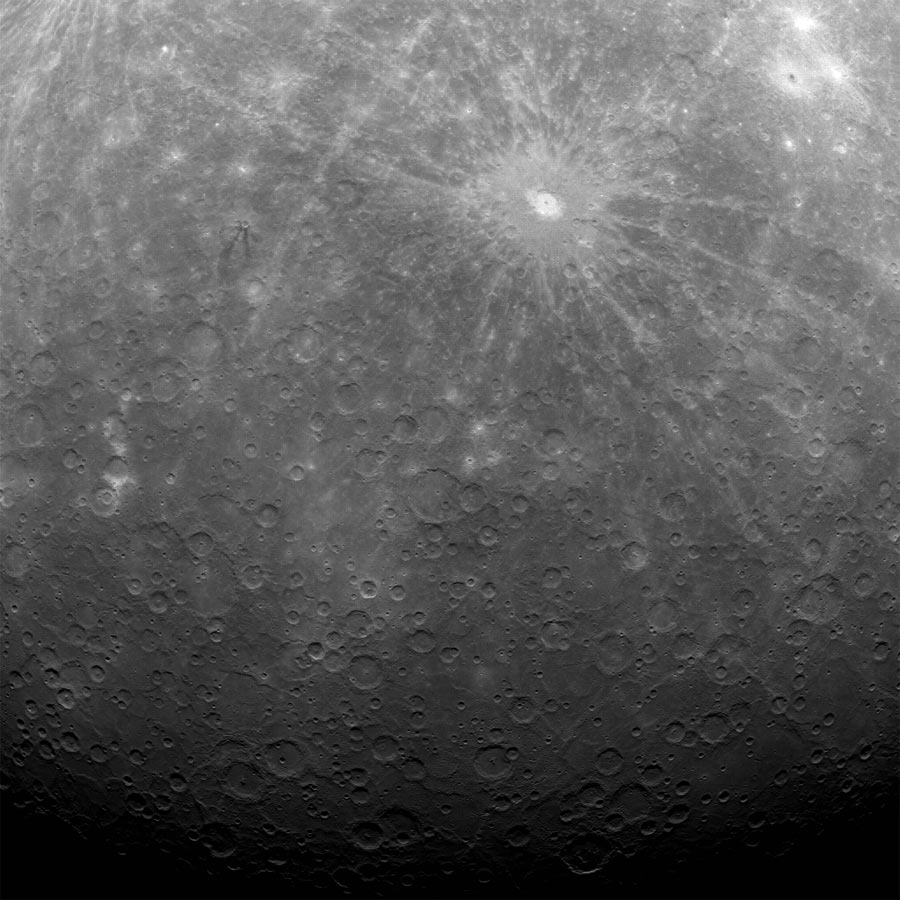NASA Spacecraft Snaps 1st Photo of Mercury from Orbit

UPDATE: The latest photos of Mercury from NASA's Messenger spacecraft can be seen here.
This story was updated at 5:32 p.m. ET.
The first spacecraft ever to circle Mercury has beamed home the first-ever photo taken of the small rocky planet from orbit, showing a stark landscape peppered with craters.
NASA's Messenger spacecraft snapped the new Mercury photo today (March 29) at 5:20 a.m. EDT (0920 GMT). The photo shows the stark gray landscape of southern Mercury, a view that is dominated by a huge impact crater. [See the first photo of Mercury from orbit]
"This image is the first ever obtained from a spacecraft in orbit about the solar system's innermost planet," Messenger mission scientists explained in a statement.
The new Mercury photo shows a region around the south pole of Mercury. A 53-mile (85-kilometer) wide crater called Debussy clearly stands out in the upper right of the image, with bright rays emanating from its center. [More photos of Mercury from Messenger]
A smaller crater called Matabei, which is 15 miles (24 km) wide and is known for its "unusual dark rays," is also visible in the image to the west of the Debussy crater, mission managers explained.
Get the Space.com Newsletter
Breaking space news, the latest updates on rocket launches, skywatching events and more!
The new Mercury photo was posted to the Messenger mission website managed by the Johns Hopkins University Applied Physics Laboratory, which is overseeing the flight for NASA.
The photo is the first of 363 snapshots Messenger took during six hours of observations around Mercury. The images are expected to cover previously unseen areas of Mercury, terrain that was missed by Messenger during three previous flybys before it entered orbit.
Messenger arrived at Mercury on March 17, more than 6 1/2 years after its launch from Earth.
The spacecraft paused in its Mercury photo reconnaissance work just long enough to beam the new images back to Earth, mission managers said.
"The Messenger team is currently looking over the newly returned data, which are still continuing to come down," Messenger mission scientists said.
NASA plans to hold a teleconference with reporters on Wednesday to review the latest Mercury discoveries by the Messenger probe. The spacecraft's name is short for the bulky moniker MErcury Surface, Space ENvironment, GEochemistry, and Ranging.
The $446 million Messenger probe is expected to spend at least one Earth year studying Mercury from orbit. The spacecraft is in an extremely elliptical orbit that brings it within 124 miles (200 kilometers) of Mercury at the closest point and retreats to more than 9,300 miles (15,000 km) away at the farthest point.
The primary science mission phase will begin on April 4, when Messenger will start mapping the entire surface of Mercury, a process that is expected to require around 75,000 images. Scientists hope the spacecraft will help answer longstanding mysteries over the planet's geology, formation and history.
While Messenger is the first mission ever to orbit around Mercury, it is not the first spacecraft to visit the planet. NASA's Mariner 10 spacecraft flew by the planet three times in the mid-1970s.
Follow SPACE.com for the latest in space science and exploration news on Twitter @Spacedotcom and on Facebook.
Join our Space Forums to keep talking space on the latest missions, night sky and more! And if you have a news tip, correction or comment, let us know at: community@space.com.

Space.com is the premier source of space exploration, innovation and astronomy news, chronicling (and celebrating) humanity's ongoing expansion across the final frontier. Originally founded in 1999, Space.com is, and always has been, the passion of writers and editors who are space fans and also trained journalists. Our current news team consists of Editor-in-Chief Tariq Malik; Editor Hanneke Weitering, Senior Space Writer Mike Wall; Senior Writer Meghan Bartels; Senior Writer Chelsea Gohd, Senior Writer Tereza Pultarova and Staff Writer Alexander Cox, focusing on e-commerce. Senior Producer Steve Spaleta oversees our space videos, with Diana Whitcroft as our Social Media Editor.









